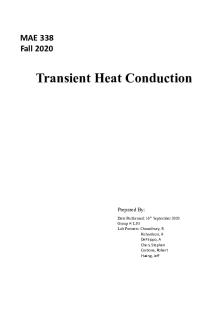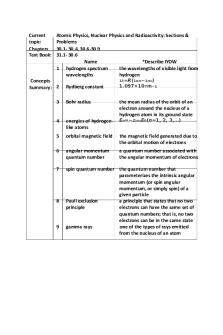Report Radioactivity PDF

| Title | Report Radioactivity |
|---|---|
| Course | Physics for Biosciences |
| Institution | University of Ontario Institute of Technology |
| Pages | 7 |
| File Size | 542.6 KB |
| File Type | |
| Total Downloads | 65 |
| Total Views | 129 |
Summary
lab report...
Description
Physics for Biosciences Laboratory
Faculty of Science, UOIT
Lab Report PB-05: Radioactivity Student’s name
CRN72890
Radioactivity - Distance 1. Vacuum is on Americium graph
Table 1.1 - Intensity of Radiation of Americium in Vacuum Bismuth 210 graph
Lab Report PB-05: Radioactivity
Date March 29, 2020
Physics for Biosciences Laboratory
Faculty of Science, UOIT
Table 1.2 - Intensity of Radiation of Bismuth 210 in Vacuum Cobalt 60graph
Table 1.3 - Intensity of Radiation Cobalt 60 in Vacuum 2. Air is on Americium graph
Table 2.1 - Intensity of Radiation of Americium in Air
Lab Report PB-05: Radioactivity
2
Physics for Biosciences Laboratory
Faculty of Science, UOIT
Bismuth 210 graph
Table 2.2 - Intensity of Radiation of Bismuth 210 in Air
Cobalt 60 graph
Table 2.3 - Intensity of Radiation Cobalt 60 in Air
Lab Report PB-05: Radioactivity
3
Physics for Biosciences Laboratory
Faculty of Science, UOIT
Radioactivity – Penetration Americium 241 graph
Table 3.1 - Ionizing Radiation of Americium 241 in a Vacuum
Radium 226 graph
Table 3.2 - Ionizing Radiation of Radium 226 in a Vacuum
Lab Report PB-05: Radioactivity
4
Physics for Biosciences Laboratory
Faculty of Science, UOIT
Bismuth 210 graph
Table 3.3 - Ionizing Radiation Bismuth 210 in a Vacuum
Thorium 234 graph
Table 3.4 - Ionizing Radiation Thorium 234 in a Vacuum
Lab Report PB-05: Radioactivity
5
Physics for Biosciences Laboratory
Faculty of Science, UOIT
Cesium 137 graph
Table 3.5 - Ionizing of Radiation of Cesium 137 in a Vacuum
Cobalt 60 graph
Table 3.6 - Ionizing of Radiation of Cobalt 60 in a Vacuum
List the alpha, beta and gamma emitters from least to most penetrating:
1. Alpha Source - Americium 241and Radium 226 2. Beta Source. - Bismuth 210 and Thorium 234 3. Gamma Source - Cesium 137 and Cobalt 60 Lab Report PB-05: Radioactivity
6
Physics for Biosciences Laboratory
Faculty of Science, UOIT
________________________________________________________________________________________
Analysis: After analyzing the data obtained, we can come to the conclusion that the samples of the Alpha emitters emitted radiation that expressed similar penetration abilities. Beta and Gamma rays on the other hand display different penetrating abilities. Gamma rays penetrate in greater depths because they can pass through the space between atoms and molecules as shown in table 3.5 and 3.6. The range of Beta emitters depend on their speed; Conclusion: The purpose of this lab is to observe the effects of air intensity radiation and the effect of the various radioactive sources – alpha, beta and gamma particles at different distances. Part one and two of this experiment, examines the effect if air on the intensity of radiation from Alpha (α) particles, Beta (β) particles and Gamma (γ) rays at various distances (10mm, 20mm, 40mm, 60mm, 80mm) were observed. The results obtained observes radiation decay per minute. Inverse Square Law (S/4πr2) supports the inversely proportional relationship displayed. Inverse Square law says that intensity equals the inverse of square of the distance from the source. For example, the radiation exposure from a point source gets smaller the farther away it is. This was shown in our results as distance increased there was a decrease in the number of counts. The medium of the air has no effect on the intensity of ionizing radiation. Part three of this experiment examines the penetrating abilities of ionizing radiations from Alpha (α) particles, Beta (β) particles and Gamma (γ) rays at various distances (10mm, 20mm, 40mm, 60mm, 80mm) were observed. According to tables 3.1 and 3.2, we can see that the alpha emitters experienced the same amount of penetration. We can see that when there is an increase in thickness of absorbers there is a decrease in the number of counts per minute. Whereas, Beta and gamma emitters emitted radiation that illustrates different penetrations. Gamma particles have the ability to penetrate through large depths in materials. Beta emitters can are dependent on speed.
We can conclude that Alpha (α) particles, Beta (β) particles and Gamma (γ) rays all exhibit different penetrations, but gamma rays have the strongest penetration ability and alpha rays exhibit the weakest penetration ability.
Lab Report PB-05: Radioactivity
7...
Similar Free PDFs

Report Radioactivity
- 7 Pages

Radioactivity Solutions
- 10 Pages

7.16 Radioactivity Dating Lab
- 3 Pages

Report
- 4 Pages

Report
- 29 Pages

Report
- 5 Pages

Report
- 5 Pages

Report-48 - ATI report
- 10 Pages

Report Writing - Incident Report
- 12 Pages

Report
- 11 Pages

Report
- 6 Pages

Work term report 1 report
- 9 Pages

Interim Report
- 27 Pages
Popular Institutions
- Tinajero National High School - Annex
- Politeknik Caltex Riau
- Yokohama City University
- SGT University
- University of Al-Qadisiyah
- Divine Word College of Vigan
- Techniek College Rotterdam
- Universidade de Santiago
- Universiti Teknologi MARA Cawangan Johor Kampus Pasir Gudang
- Poltekkes Kemenkes Yogyakarta
- Baguio City National High School
- Colegio san marcos
- preparatoria uno
- Centro de Bachillerato Tecnológico Industrial y de Servicios No. 107
- Dalian Maritime University
- Quang Trung Secondary School
- Colegio Tecnológico en Informática
- Corporación Regional de Educación Superior
- Grupo CEDVA
- Dar Al Uloom University
- Centro de Estudios Preuniversitarios de la Universidad Nacional de Ingeniería
- 上智大学
- Aakash International School, Nuna Majara
- San Felipe Neri Catholic School
- Kang Chiao International School - New Taipei City
- Misamis Occidental National High School
- Institución Educativa Escuela Normal Juan Ladrilleros
- Kolehiyo ng Pantukan
- Batanes State College
- Instituto Continental
- Sekolah Menengah Kejuruan Kesehatan Kaltara (Tarakan)
- Colegio de La Inmaculada Concepcion - Cebu


